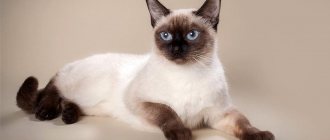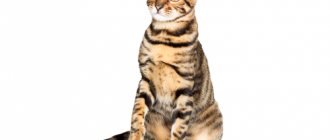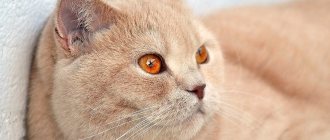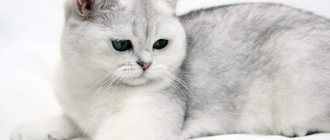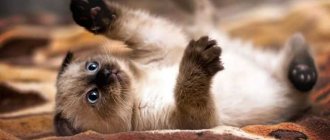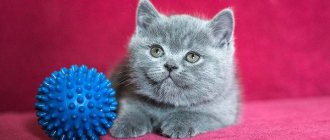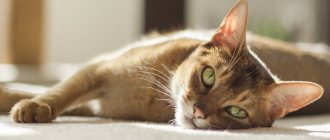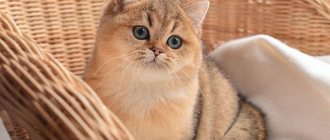British cats are distinguished by their coat palette: diverse, complex and rare in color. The British lilac, recently bred by English selectors, delights with the richness and sophistication of its color. With shades of varying intensity, it appealed to fans of the British cat breed and became popular.
Features of color
Of the two hundred different colors of animal fur, the lilac Briton delights with its tenderness, subtlety, lilac or lilac tones. The peculiarities of this color are the following shades: gray-pink; lavender; isabella Felinologists can distinguish every subtle tone. This color is difficult to both describe in words and convey in photographs.
The light one is reminiscent of lavender, akin to pink with a cool silvery tint;
The middle one is called warm lilac, close to cream with a slightly purple tint;
Dark or isabella, like coffee diluted with milk.
The right approach to feeding
The Lilac Briton's diet should be healthy and balanced. If the cat is on natural feeding, the following food should be present:
- turkey;
- chicken;
- rabbit;
- veal;
- eggs;
- vegetables;
- cereals
Veterinarians from the Zoovet clinic do not recommend giving fish and fermented milk products more than once a week. If necessary, the diet can be diluted with industrial complementary foods, but when choosing them it is important to take into account the gender, age and health status of the pet. It is recommended to focus on premium segment feeds.
Origin of color.
At the end of the last 29th century, English breeders worked on the breed for 10 years. Experimental matings were carried out between cats and cats of chocolate color with a strong gene and blue cats with a weak one. As a result of painstaking work, we achieved an amazing result: a lilac British cat of an exclusive color. The color was adopted by felinologists 30 years ago, registered as an independent standard species with the official international names Lavender and Lilac, the breed and color are indicated in the passport with the letter “c”.
Myths and reality of cat colors
The diversity and variability of cat colors has been laid down by nature itself since ancient times . After all, the wild ancestors of our cute purrs had to survive by adapting to a variety of environmental conditions - where those with spotted or striped “camouflage” had the best chances. But the real color potential of cats began to gradually reveal itself when they entered the service of humans.
Color, as it turned out, matters
At first, people were much more interested in the behavioral qualities of the cat - its hunting skills; the selection went in this direction. But the prerequisites for the emergence and consolidation of new colors have become much greater. In many countries, cats were endowed with mystical properties and even deified, so the birth of kittens of an unusual color attracted attention - many very old signs, beliefs and superstitions are associated with cats of a certain color: black, white, red...
Famous British palette
The British breed is good in many respects, but is especially famous for the variety of its colors. The standards of felinological organizations recognize that the British have more than 250 color variations of their fur coats, which can be short, long, fluffy, inherited from the Persians.
A variety of British colors can be represented even in one litter
It was the Persians who gave British cats a motley palette of colors. British women had a much poorer color “assortment” until Persian blood began to flow into the breed - it is believed that the lilac shades were obtained precisely from oriental cats. Such “inbreeding” with Persian, Carthusian and outbred cats was necessary to preserve and develop the breed during difficult periods for it.
British Shorthair
Shorthair British lilac cats are large animals with a powerful, proportional body, with hair uniformly distributed in color throughout the body. The weight of males can reach up to 6 kg, females are much lighter, up to 4 kg.
Description of the standard nuances that British lilac has:
- The head is large with rounded outlines, a wide nose, plump cheeks covered with wool of a basic tone;
- The fur on parts of the body is evenly colored along its length;
- On the neck of the British Lilac cat there is a necklace in the form of a small fold;
- Short, strong paws with pinkish pads;
- The fleshy tail is colored to the rounded tip;
- Widely spaced, medium-sized ears with slightly rounded tips are covered with wool of a basic tone;
- Eye color varies depending on the shade; copper; amber; orange.
Upbringing
Breeders believe that the lilac color of British cats affects their character. Such pets demonstrate an increased level of learning ability. Unlike blue-gray Britons, they love communication.
Lilac cats enjoy being the center of attention, as long as they choose to do so. A cat that gets into a large family at an early age shows less independence and independence, which is characteristic of the British breed.
How to get color
Breeding lilac British cats, this rare color, is almost difficult for owners to obtain at home. Purposeful, painstaking selection by experienced breeders, with the selection of parental pairs, with knowledge of genetics, only in 25% ends in obtaining the desired result, like the producers.
Obtaining colors depends on the presence of certain pigments in the animal’s fur in the form of two melanins:
- pheomelanin - red-yellow,
- eumelanin – black.
The final shade affects the ratios in which these pigments are found in relation to each other. Even when a cat and cat become carriers of the desired gene, there is no firm certainty that the kittens born will be of a rare color. Therefore, practicing breeders do not recommend mating two lilac sires with each other. Such mating results in offspring with a grayish dirty tone in color, and the pink note disappears.
Experienced breeders achieve the birth of standard lilac offspring by breeding cats and cats of blue and chocolate color, which contain recessive genes.
When only three variants of parental pairs are mated, they get different colors in intensity, if towards purple:
- + blue, light reminiscent of lavender;
- + chocolate, medium close to cream;
- + black, dark or isabella;
Kittens
The color of a child's coat from birth differs in color as it matures. By the age of one and a half years, the tone gradually changes and becomes purple. The initially gray-blue tint of the paw pads, nose and edging of the mucous membranes begins to acquire the main color, and the blue and gray eyes become yellowish, golden or copper. Up to 5 months, kittens have grayish spots and stripes, but then in purebred lilac kittens, the attachments disappear. In a mature pet, the fur becomes the same color out of three possible shades.
Video “Funny British cat babies”
The video shows newborn kittens of lilac and chocolate color.
Was this article helpful?
Thank you for your opinion!
The article was useful. Please share the information with your friends.
Yes
No
X
Please write what is wrong and leave recommendations on the article
Cancel reply
Rate the benefit of the article: Rate the author ( 1 vote(s), average: 5.00 out of 5)
Discuss the article:
Who is the lilac Briton suitable for?
When choosing a Lilac pet, the important arguments are:
- British kittens, like their parents, have the same lilac-colored characteristics that will be a source of pride for their owner.
- The British have a soft, good-natured character; pets immediately become family favorites.
- Lilac is brought into a home with small children, and they get along well.
- They tolerate loneliness calmly and do not get bored, which is important for busy owners.
- Balanced by nature, they are clean and will not create a mess in the house.
Character and behavior
The character of these cats is independent, quite independent. They are characterized by impressiveness, sedateness, good manners and a developed sense of tact. They know how to spend time alone and need personal territory. They don’t like being forcibly held, squeezed, or stroked.
At the same time, the British are able to tenderly become attached to people, without singling out the main owner in the family, and are friendly towards children, if they do not allow themselves too much.
Be careful with strangers; the cat will need time to get to know the guest; you should not speed up the process. Get along well with other pets. The combination of self-sufficiency with kindness and intelligence makes them excellent friends for owners who spend a lot of time outside the home.
History of colors in the breed
Almost all Britons had blue coats until the mid-20th century. After targeted selection and crossing of these cats with representatives of other breeds, exotic colors appeared. For example, color-point, like Siamese.
Interestingly, the chinchilla color appeared in 1973. Then one European felinologist brought the Briton together with a chinchilla cat.
White cats appeared before, but in the 80s of the 20th century, some organizations banned their mating with each other so that deaf kittens would not be born.
History of appearance
The British Shorthair originates from England and has been known since the 19th century. The British lilac cat owes its appearance to the many years of work of breeders and breeders. Lilac Britons are not a separate breed, they are just British Shorthair cats with the most popular shade of lilac fur.
The unusual color was formed not under the influence of a color gene, but as a result of crossing recessive forms of animals of chocolate and blue colors. Moreover, only 25% of the offspring have this color.
There is a misconception that the purple coat color is the result of crossing a Scottish Fold and a marbled cat. But such crossing not only does not give the desired color, but also leads to genetic failures.
The lilac color of British cats is popular not only in the UK, but throughout the world.
Choosing a suitable nickname
The nickname should reflect the character or emphasize the origin. British cats are most often called by English names. For exhibition animals, names are taken from ancient Greek mythology, such as Orpheus, Zeus, Athena. Names starting with “L” are suitable for cats with a soft character: Lisa, Lapa, Laska. Slavic names may be suitable for cats, for example, Tikhon or Trofim. Cats with a rich pedigree are called so as to emphasize their aristocratic origin: Count, Marquise or Baron.
The nickname should not be too long, otherwise the animal will not remember it. The optimal length is 2-3 syllables.
How coat color changes with age
In kittens, the outer hair looks like soft fluff, and the shade is not yet saturated, like in adults. The true color appears after puberty. Then junior molting occurs, especially pronounced in males.
The structure of the coat changes, it becomes denser and rougher to the touch. The pattern becomes blurry, and some kittens' spots disappear.
Important: In summer, the wool fades in the sun, and in winter it darkens. Also, after 3 years, the color becomes brighter and more saturated. Food affects the shade; in white kittens, the fur darkens due to carrots and beets.
Cat diseases
The British suffer little illness, but are genetically prone to heart and kidney disease. The risk is reduced if both parents were healthy. With poor nutrition they suffer from obesity.
Lilac cats may have corneal clouding or drooping third eyelids. If left untreated, otitis media or gum disease may develop.
The cat must be vaccinated against viral diseases:
- rabies;
- plague;
- calcivirosis;
- feline immunodeficiency.
It is important to follow the vaccination schedule, especially if your pet is outdoors, attends exhibitions or comes into contact with other cats.
Popular colors for kittens
In the media and various illustrations, British kittens of a certain color are often found. This formed the opinion that true representatives of the British breed are only blue or whiskey colored.
In fact, more than 200 variants are recognized in the breed, including combinations of the main ones.
Popular colors:
- Blue;
- Gray with stripes;
- White with chocolate spots;
- Gray background with bright marble.
Recently, British chinchillas have been gaining popularity. About 1/8 of their hair is dyed, and the roots are very light. In smoky cats, dark pigment of any color occupies the largest part.
PHOTOS OF LIVEL BRITISH KITTENS
Below is a gallery of photos of lilac British kittens.
| In our cattery you can “buy a real British kitten.” We have many different colors, we will help you choose and answer all your questions! |
Please rate the article!
(1 star - didn't like it, 5 stars - liked it) Thank you!
Possible colors in the breed
Today the following groups are allowed:
- Solid;
- Patterned;
- Tortoiseshells;
- With white;
- Tipped;
- Silver;
- Golden.
Solid or solid cats are distinguished by their purity and uniform distribution of color. Black kittens from this group show a remnant of the tabby pattern, but after a few months it disappears without a trace.
According to the laws of genetics, in ginger cats (genetically red), stripes or dots are always visible on the coat.
Much attention is paid to smoky or silver options. Upon closer inspection, it is noticeable that their undercoat is much lighter than the main color.
Goldens have similar manifestations, but this color is rare in British kittens, but it looks impressive.
Tortoiseshell cats are born with two- or three-color coats. Males from this group are rarely born and cannot continue the race due to the characteristics of the body. The distribution of color spots is uniform; if black or red predominates, then this is considered a defect.
Patterned ones are divided into striped, spotted and marbled. The latter have a pattern on the sides that looks like thick lines twisted into a spiral. They are called rosettes. This color is very valuable.
Important: Britons with blue coats cannot have a silver tint.
